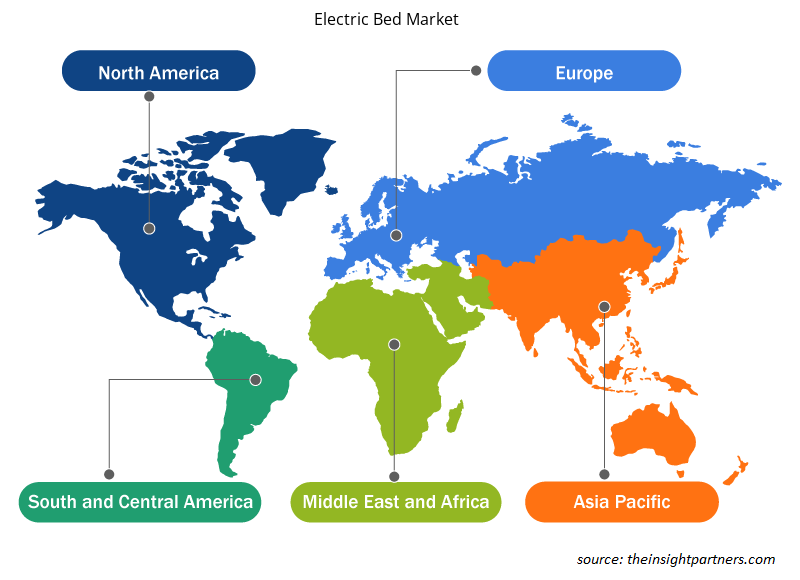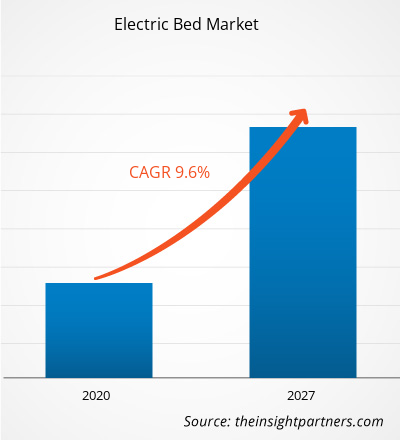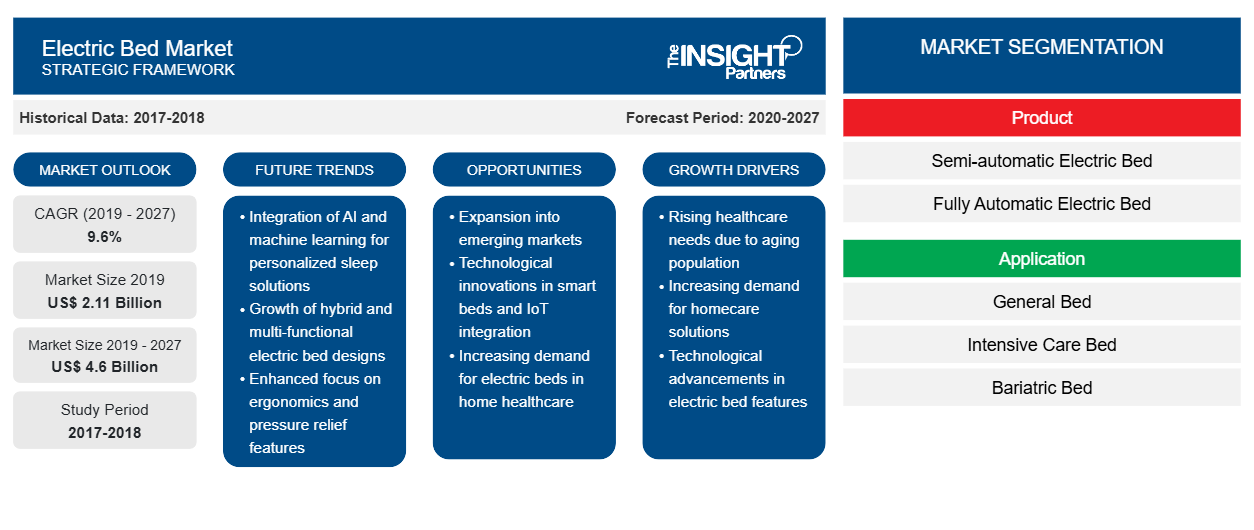Se espera que el mercado de camas eléctricas alcance los 4.597,60 millones de dólares estadounidenses en 2027, frente a los 2.111,59 millones de dólares estadounidenses de 2019. Se estima que el mercado crecerá a una CAGR del 9,6 % entre 2020 y 2027.
El crecimiento del mercado se atribuye a factores impulsores clave como el aumento de la cantidad de enfermedades crónicas, el aumento de la cantidad de hospitales y clínicas y el aumento de la cantidad de asociaciones público-privadas en la industria de la atención médica. Sin embargo, es probable que los altos precios de las camas eléctricas y la reducción de la duración promedio de las estadías hospitalarias obstaculicen el crecimiento del mercado de camas eléctricas .
Perspectivas del mercado
Aumento de la prevalencia de enfermedades crónicas
Las camas se encuentran entre los artículos esenciales que se utilizan en hospitales, residencias de ancianos y entornos de atención domiciliaria. Las camas eléctricas, que se utilizan en diversas aplicaciones, están disponibles en variantes especializadas, como camas de cuidados agudos, camas de cuidados a largo plazo, camas psiquiátricas y camas de embarazo. Los pacientes que padecen enfermedades ortopédicas y musculoesqueléticas tienen movimientos restringidos y carecen de flexibilidad. Las camas eléctricas ofrecen ajustes automáticos con respecto a la colocación de la cabeza, la altura y la posición de descanso de las piernas para estos pacientes. Según la Organización Mundial de la Salud (OMS), las enfermedades musculoesqueléticas contribuyen en gran medida a las discapacidades totales en el mundo. Según la OMS, en 2018, el cáncer fue la segunda causa principal de muerte en todo el mundo, se notificaron ~9,6 millones de muertes en 2018. Además, según las estimaciones de la Sociedad Estadounidense del Cáncer, en 2018 se diagnosticaron 1.735.350 nuevos casos de cáncer. Los pacientes en etapas más avanzadas del cáncer pierden su capacidad para realizar varias tareas fisiológicas por sí mismos, y las camas eléctricas ayudan al personal sanitario a cuidar de estos pacientes.
Así, la creciente prevalencia de enfermedades crónicas como las enfermedades cardiovasculares (ECV), el cáncer y la diabetes incrementan la demanda de camas eléctricas.
Personalice este informe según sus necesidades
Obtendrá personalización en cualquier informe, sin cargo, incluidas partes de este informe o análisis a nivel de país, paquete de datos de Excel, así como también grandes ofertas y descuentos para empresas emergentes y universidades.
- Obtenga las principales tendencias clave del mercado de este informe.Esta muestra GRATUITA incluirá análisis de datos, desde tendencias del mercado hasta estimaciones y pronósticos.
Perspectivas regionales del mercado de camas eléctricas
Los analistas de Insight Partners explicaron en detalle las tendencias y los factores regionales que influyen en el mercado de camas eléctricas durante el período de pronóstico. Esta sección también analiza los segmentos y la geografía del mercado de camas eléctricas en América del Norte, Europa, Asia Pacífico, Oriente Medio y África, y América del Sur y Central.

- Obtenga los datos regionales específicos para el mercado de camas eléctricas
Alcance del informe de mercado de camas eléctricas
| Atributo del informe | Detalles |
|---|---|
| Tamaño del mercado en 2019 | US$ 2.11 mil millones |
| Tamaño del mercado en 2027 | 4.600 millones de dólares estadounidenses |
| CAGR global (2019-2027)CAGR (2019 - 2027) | 9,6% |
| Datos históricos | 2017-2018 |
| Período de pronóstico | 2020-2027 |
| Segmentos cubiertos | Por producto
|
| Regiones y países cubiertos | América del norte
|
| Líderes del mercado y perfiles de empresas clave |
|
Densidad de actores del mercado: comprensión de su impacto en la dinámica empresarial
El mercado de camas eléctricas está creciendo rápidamente, impulsado por la creciente demanda de los usuarios finales debido a factores como la evolución de las preferencias de los consumidores, los avances tecnológicos y una mayor conciencia de los beneficios del producto. A medida que aumenta la demanda, las empresas amplían sus ofertas, innovan para satisfacer las necesidades de los consumidores y aprovechan las tendencias emergentes, lo que impulsa aún más el crecimiento del mercado.
La densidad de actores del mercado se refiere a la distribución de las empresas o firmas que operan dentro de un mercado o industria en particular. Indica cuántos competidores (actores del mercado) están presentes en un espacio de mercado determinado en relación con su tamaño o valor total de mercado.
Las principales empresas que operan en el mercado de camas eléctricas son:
- Dispositivos médicos Arjo
- Compañía: Hill Rom Holding, Inc.
- Industrias Medline, Inc.
- Compañía: Paramount Bed Holdings Co., Ltd.
- Corporación Invacare
Descargo de responsabilidad : Las empresas enumeradas anteriormente no están clasificadas en ningún orden particular.

- Obtenga una descripción general de los principales actores clave del mercado de camas eléctricas
Mercado de camas eléctricas: por producto
- Cama eléctrica semiautomática
- Cama eléctrica totalmente automática
Mercado de camas eléctricas: por aplicación
- Cama general
- Cama de cuidados intensivos
- Cama bariátrica
- Cama de parto
Mercado de camas eléctricas: por usuario final
- Hospitales y Clínicas
- Odontología
- Otros
Mercado de camas eléctricas por geografía
América del norte
- A NOSOTROS
- Canadá
- México
Europa
- Francia
- Alemania
- Italia
- Reino Unido
- España
- Resto de Europa
Asia Pacífico (APAC)
- Porcelana
- India
- Corea del Sur
- Japón
- Australia
- Resto de Asia Pacífico
Oriente Medio y África (MEA)
- Sudáfrica
- Arabia Saudita
- Emiratos Árabes Unidos
- Resto de Oriente Medio y África
América del Sur y Central
- Brasil
- Argentina
- Resto de América del Sur y Central
Perfiles de empresas
- Dispositivos médicos Arjo
- Compañía: Hill Rom Holding, Inc.
- Industrias Medline, Inc.
- Compañía: Paramount Bed Holdings Co., Ltd.
- Corporación Invacare
- Corporación Stryker
- Balneario Malvestio
- Línea
- Gendron Inc.
- Joerns Salud LLC
- Análisis histórico (2 años), año base, pronóstico (7 años) con CAGR
- Análisis PEST y FODA
- Tamaño del mercado, valor/volumen: global, regional y nacional
- Industria y panorama competitivo
- Conjunto de datos de Excel
Informes recientes
Informes relacionados
Testimonios
Razón para comprar
- Toma de decisiones informada
- Comprensión de la dinámica del mercado
- Análisis competitivo
- Información sobre clientes
- Pronósticos del mercado
- Mitigación de riesgos
- Planificación estratégica
- Justificación de la inversión
- Identificación de mercados emergentes
- Mejora de las estrategias de marketing
- Impulso de la eficiencia operativa
- Alineación con las tendencias regulatorias





















 Obtenga una muestra gratuita para - Mercado de camas eléctricas
Obtenga una muestra gratuita para - Mercado de camas eléctricas